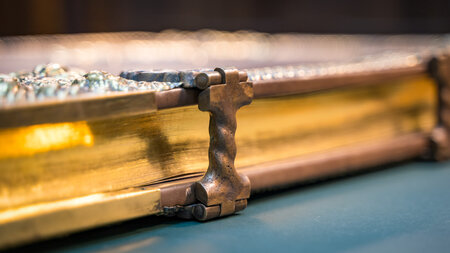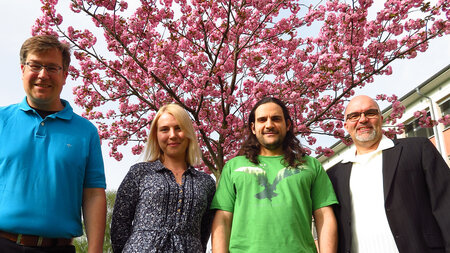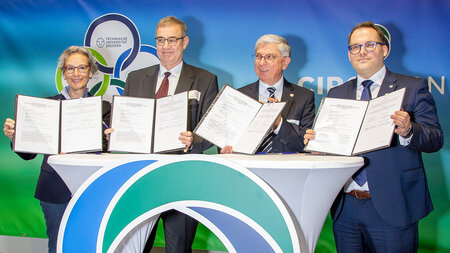|
Chemnitz, formerly one of the most important industrial cities of Germany, is located in
the Western part of Saxony and it is the third biggest city in the state
following Dresden and Leipzig. The city, which is currently undergoing great changes, is
part of the "Saxon triangle metropolitan area". |
|
During the industrial revolution Chemnitz became home to a wide range of groundbreaking mechanical industries and thus enforced the development of a progressive bourgeoisie, which of course is reflected in the architectural footprints left behind from this time. Kaßberg is the largest intact quarter of Art Nouveau buildings in the whole of Europe. It came through World War II relatively unscathed and therefore still breathes the life of that bygone era and it is one of Chemnitz' most sought after residential areas. The mechanical industry and its focus on cloth production and weaving brought about some of the greatest and most progressive industry tycoons of this sector who of course sought for ways to represent their social status and found architecture to be an outlet fit for their purposes. Therefore Chemnitz proudly sports several highlights of modern architecture. Of great renown is Villa Esche, designed and built by Art Nouveau architect Henry van de Velde for a captain of the industry and finished in 1911, was the first residential building by van de Velde.
The city centre contrasts this with its commercial architecture mostly erected during
the last decade. To name a few, the Arab-inspired look of the Galerie Roter Turm shopping mall, designed by the famous architect Kollhoff, supposedly reflects the longing of Chemnitz for a fairy-tale history, or rather any history at all since almost 90% of the historic city centre was destroyed in the last months of World War II. Another two impressive buildings built during the last few years which close the gaps in
the city centre are the Galeria Kaufhof and P&C department stores. These three and
the old town hall provide the frame for the bustling café life in the market square -
a meeting point for senior citizens and students alike.
DAStietz houses the Museum of Natural History, the MNew Saxonian Gallery and a most singular exhibit, the stone forest. These are large trees, which
turned to stone during the past millennia and were discovered in old swamps, they were
dug out and now adorn the foyer of the building. Reaching up to the 4th floor in the
building, they are a unique sight to behold. Nowadays, the city provides its inhabitants and visitors with a great quality of life and a variety of places serve to entertain the flâneur.
Chemnitz city centre offers the visitor a broad range of culinary opportunities. Chinese, French, Japanese, Mexican, Greek, Czech and of course traditional German cuisine can be found within walking distance from the market square. Furthermore cafés and bistros serve the coffee or tea-time enthusiast. Cultural events in Chemnitz are usually hosted in the Schauspielhaus theatre, the Stadthalle concert hall or in smaller venues like Weltecho or DiFranco Deluxe, which cater to various needs. Every week concerts, readings, plays or films enrich and complement the highbrow offers of the afore-mentioned traditional institutions. |
|
The congress takes place on the campus of the Chemnitz University of Technology. |
| In order to guarantee accommodation to the participants, we have made arrangements with the hotels "Chemnitzer Hof" (C) and "Hotel an der Oper" (B) as well as with Hotel Mercure (D). Both are within 4 minutes' walking distance from Chemnitz Hauptbahnhof (A) train station and Omnibus-Bahnhof bus station (see map below).
The special prize for a single room is EUR 59,00 (Chemnitzer Hof) and EUR 58,00 (Hotel an der Oper) or EUR 63 (Mercure). If you prefer other modalities of accommodation (like youth hostel) please contact the organisers.
Important note:
Visitors to the conference registering after 12 March 2009, please contact Hotel Mercure because the other two are fully booked. Größere Kartenansicht |
|
|
|
|

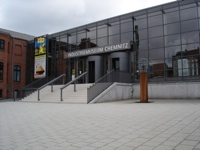 Chemnitz city boasts a great number of telltale architectural
sights from its industrial past in the late 19th and early 20th centuries. This era
long-gone still dominates the impression guests of Chemnitz have of this town as the
buildings from these times still cast a spell on the onlooker and work their magic on
anyone interested in the aesthetics of modern industrial architecture.
Chemnitz city boasts a great number of telltale architectural
sights from its industrial past in the late 19th and early 20th centuries. This era
long-gone still dominates the impression guests of Chemnitz have of this town as the
buildings from these times still cast a spell on the onlooker and work their magic on
anyone interested in the aesthetics of modern industrial architecture.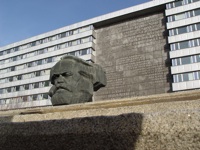 In 1953 Chemnitz became Karl-Marx-Stadt in honour of the grandfather of Socialism, who was also revered by a monumental bust of the head of Karl Marx installed in 1971. It is still in its original place just off Straße der Nationen across from the Stadthalle concert hall. Visitors to Chemnitz are awed because of its size (it is the second largest head bust in the world after the Sphinx in Egypt) and the urban design
provides an appropriate background for the work.
In 1953 Chemnitz became Karl-Marx-Stadt in honour of the grandfather of Socialism, who was also revered by a monumental bust of the head of Karl Marx installed in 1971. It is still in its original place just off Straße der Nationen across from the Stadthalle concert hall. Visitors to Chemnitz are awed because of its size (it is the second largest head bust in the world after the Sphinx in Egypt) and the urban design
provides an appropriate background for the work.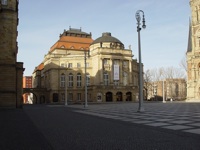 Chemnitz having been home to Karl-Schmidt-Rottluff, Kunstsammlungen hosts a great number of German impressionist and expressionist pieces of art as well as short-time exhibitions on different subjects, from Lukas Cranach to Bob Dylan's Drawn Blank series.
The newly opened Gunzenhauser Museum has a similar focus on German
impressionist painting and is also famed for its clever re-construction of the building
which used to be Germany's first vending machine restaurant in the 1920s and later on housed a bank until its modern design was deemed the perfect backdrop for the Gunzenhauser collection..
Chemnitz having been home to Karl-Schmidt-Rottluff, Kunstsammlungen hosts a great number of German impressionist and expressionist pieces of art as well as short-time exhibitions on different subjects, from Lukas Cranach to Bob Dylan's Drawn Blank series.
The newly opened Gunzenhauser Museum has a similar focus on German
impressionist painting and is also famed for its clever re-construction of the building
which used to be Germany's first vending machine restaurant in the 1920s and later on housed a bank until its modern design was deemed the perfect backdrop for the Gunzenhauser collection.. The "Theaterplatz" bus stop is next to the hotel.
The "Theaterplatz" bus stop is next to the hotel.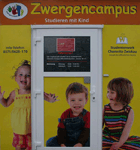 The congress Ideas of Europe/Ideas for Europe will provide a child care for registered attendants at our "Zwergencampus". For further information please contact us.
The congress Ideas of Europe/Ideas for Europe will provide a child care for registered attendants at our "Zwergencampus". For further information please contact us.
